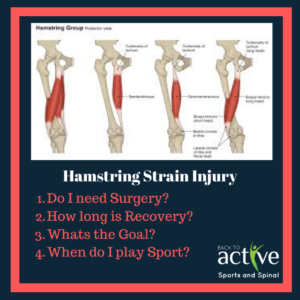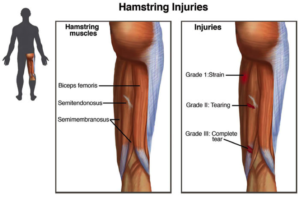Hamstring strain injuries

Runners, sprinters, rubgy, oztag or soccer players beware. Whether you’re Usain bolt or just a weekend NFL superstar, everyone should have or at least know about have preventative measures against hamstring strain injuries. Hamstring strains are quite the predicament. In the NFL alone, they account for 12% of all injuries at a whopping 32% recurring rate, even for professional athletes.
Hamstring strains or tears are hard to predict and painfully frustrating for the victim. They are associated with a long rehabilitative process and have a tendency to reoccur when rehabilitation is not guided or at all participated in.
Common questions:
Do I need surgery?
Most hamstring tears will not warrant surgical intervention. Surgery is only required if the hamstring has teared off the bone (as opposed to a tear within the bulk of the muscle); this is called a proximal avulsion.
How long will I need to rest for? How long is recovery?
Although it is hard gauge how athletic the reader is and write a tapered response to the reader, recreational runners will need 16 weeks, on average, to return to sport without restrictions. Even in the professional sphere of athletes, it is compulsory that soccer players take 2 weeks off. Therefore, for any average joe, expect the whole recovery period taking anywhere between 4 months to one year for a full recovery.
What’s the goal?
The main goal for all hamstring strains is to return the patient to sport/function, without pain, and with nominal risk of re‐injury. In particular, we also need to be vigilant regarding potential scar tissue which may develop around the strain; and vigilant regarding how well the injured hamstrings are firing. Evidence says deems that after a hamstring is initially strained or tear, it has the potential to lose how well the muscle fires and the strength at which it fired. Attending to this will decrease risk of re-strain.
When can I get back to sport?
Although in the aforementioned question recovery full recovery may take as long as one year for a hamstring strain, tentative return to sport may start before the completion of recovery. Tentative return to sport and disciplined performance may occur concurrently when the patient is training sport specific exercises. For example, in a 16 week time frame, the patient may have a slow return to sport at 8 – 12 weeks.

Signs and Symptoms
- Bruising (deep red or purple pooling)/ecchymosis
- Pain when walking, running, jumping
- Swelling/ skin is hot to touch
- Feeling a distinct pop or tearing of the muscle
- Inability to contract any portion of your hamstrings to any degree.
Risk factor
- Increasing age
- Recurring injury
- Fatigue
- Reduced flexibility
- Strength imbalance
Solution
Immediate management within the first 48- 72 hours should always include the RICER (rest, ice, compression, elevation and referral) protocol. This will reduce pain, bruising and swelling and encourage healing to the injured tissue. Following the first initial few days or even first week, can gentile range of motion and progressive strengthening by introduced.
Here’s an example of a set of simple guidelines for someone with an acute hamstring strain:
Disclaimer, that by no means is this program a substitute for professional guidance. To position yourself to optimise benefits from any program, make sure that the program is tapered to your needs.
Phase 1
- Gentile range of motion
- Hamstring isometrics (contracting the muscle without moving the joint)
- Within the acute phase, extremely light stretching and light foam rolling will encourage regrowth of orientated hamstring fibres without fibrotic changes.
- General stretching and strengthening of adjacent muscle groups (i.e glutes, calves and quads) – Clam exercise, hip thrusts and fire hydrants 3 x 10
Phase 2 (strength and balance)
- Eccentric augmented Nordic curls 3 x 10
- Theraband hamstring curls (progressively increasing tensile strength) 3 x 10
- Hamstring curl on swiss ball 3 x 10
- Ballistic hamstring kicks on bosu ball 4 x 15
- Bosu ball squats 3 x 10
- Bulgarian squats
- Low weight/body weight Deadlift variations
Phase 3 (Gradual integration of sport specific exercises)
- Single leg hamstring curl with swiss ball
- Nordic curls
- Plyometric based exercises (skater jumps, bound jumps, etc)
Phase 4 (Full strength without pain, Full pain free ROM, Pain free sport specific activities)
- Return to sport, maintenance and prevention
Professional help for Hamstring strains should definitely be sought after. This is to make sure that the muscle is properly healed, optimising strength and decreasing risk of reinjury. By getting on top of this problem, professional physiotherapy may also help you run faster, jump higher and achieve overall sport specific improvements
Written by Joshua Shum Physiotherapist
